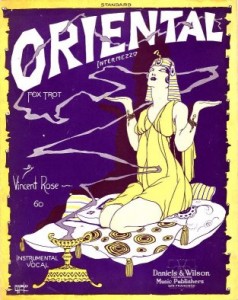 “Orientalism” is a way of seeing that imagines, emphasizes, exaggerates and distorts differences of Arab peoples and cultures as compared to that of Europe and the U.S. It often involves seeing Arab culture as exotic, backward, uncivilized, and at times dangerous. Edward W. Said, in his groundbreaking book, Orientalism, defined it as the acceptance in the West of “the basic distinction between East and West as the starting point for elaborate theories, epics, novels, social descriptions, and political accounts concerning the Orient, its people, customs, ‘mind,’ destiny and so on.”
“Orientalism” is a way of seeing that imagines, emphasizes, exaggerates and distorts differences of Arab peoples and cultures as compared to that of Europe and the U.S. It often involves seeing Arab culture as exotic, backward, uncivilized, and at times dangerous. Edward W. Said, in his groundbreaking book, Orientalism, defined it as the acceptance in the West of “the basic distinction between East and West as the starting point for elaborate theories, epics, novels, social descriptions, and political accounts concerning the Orient, its people, customs, ‘mind,’ destiny and so on.”
According to Said, Orientalism dates from the period of European Enlightenment and colonization of the Arab World. Orientalism provided a rationalization for European colonialism based on a self-serving history in which “the West” constructed “the East” as extremely different and inferior, and therefore in need of Western intervention or “rescue”.
Examples of early Orientalism can be seen in European paintings and photographs and also in images from the World’s Fair in the U.S. in the 19th and early 20th centuries.
The paintings, created by European artists of the 19th and early 20th centuries, depict the Arab World as an exotic and mysterious place of sand, harems and belly dancers, reflecting a long history of Orientalist fantasies which have continued to permeate our contemporary popular culture.
France colonized Algeria from 1830 to 1962. From roughly 1900 to 1930, French entrepreneurs produced postcards of Algerian women that were circulated in France. While Algerian women are portrayed in these photographs as if the camera is capturing a real moment in their everyday lives, the women are actually set up in the photographer’s studio. As demonstrated in Malek Alloula’s book, The Colonial Harem, these photographs were circulated as evidence of the exotic, backwards and strange customs of Algerians, when, in fact, they reveal more about the French colonial perspective than about Algerian life in the early 1900s. This is an example of how Arab women have been exoticized and eroticized for the pleasure of the European male voyeur, as these photographs make visible French colonial fantasies of penetrating the harem and gaining access to Arab women’s private spaces.
The World’s Fairs in Chicago (1893) and St. Louis (1904) helped to reinforce Orientalist imagery in the United States. The crossover from European to U.S. Orientalism can be seen in the images from James Buel’s photographic book that catalogued the 1893 World’s Fair in Chicago. This publication includes photographs of recreated Arab streets, accompanied by captions that capture the Orientalist thinking of the time. For example, the caption that accompanies the image “Egyptian Girl in Street of Cairo” refers to the “peculiar manners of the Egyptians,” and her “unsightly disguise.” In addition to being written about as an object on display, her characteristics are described as belonging to a backwards culture.
Full Title: What is Orientalism?
Author/Publisher: Arab American National Museum (AANM)
Publication Date: January 2014
Learn all about NGOs in the MENA region
MENA’s first free click-to-donate platform – you click, we donate





Copyright © 2024 The Olive Tree SAL, all rights reserved. Terms of Use | Privacy Policy